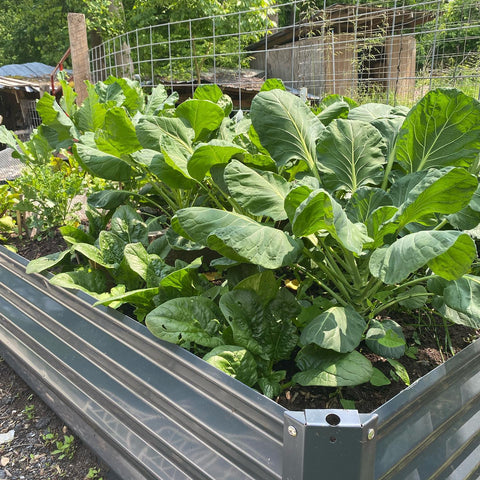Imagine a garden where the magic of pollination happens within the confines of each flower, a self-sustaining ecosystem where plants carry out their intricate dance of reproduction without the need for external assistance. Step into the realm of self-pollinating plants, where nature has granted us a unique ability that revolutionizes our approach to gardening. Throughout this in-depth exploration, we will unravel the intricacies of self-pollination, identify the plants engaged in this captivating process, and reveal the advantages that render them an intriguing inclusion in any garden.The following content also has some reference value for raised garden beds.
What is Self-Pollination?
Self-pollination is a botanical phenomenon where a flower's reproductive organs facilitate the transfer of pollen from the male structures (anthers) to the female structures (stigma) within the same flower. In essence, the plant becomes its own matchmaker, eliminating the need for external agents like wind, insects, or animals to transport pollen between flowers.

The Self-Pollination Process: Nature's Ingenious Design
In self-pollinating plants, the typical process involves the anthers releasing pollen directly onto the stigma, initiating fertilization. This close connection ensures a high level of reproductive success, as the genetic material from a single plant is utilized.
Meet the Self-Pollinators: Garden Allies in Autonomy
1. Tomatoes
These culinary stars not only grace our plates with flavorful fruits but also showcase the art of self-pollination. The design of the tomato flower supports effective self-pollination, making it a reliable choice for any garden.
2. Peas
The humble pea plant exemplifies self-sufficiency in the plant kingdom. Its flowers are designed to facilitate self-pollination, ensuring a reliable harvest of tender peas.
3. Beans
Beans, both pole and bush varieties, have embraced the self-pollination strategy. This inherent trait contributes to the ease with which these plants produce pods filled with nutritious beans.
4. Lettuce
In the world of leafy greens, lettuce stands out as a self-pollinating champion. Its inconspicuous flowers carry out the pollination dance quietly, resulting in the formation of seeds.

5. Eggplants
Eggplants boast a distinctive floral structure that encourages self-pollination. The effectiveness of this process guarantees a consistent harvest of these shiny, purple vegetables.
6. Strawberries
While strawberries are capable of self-pollination, they often benefit from external pollinators for enhanced fruit development.
7. Bell Peppers
Like their close relative (tomatoes), bell peppers are self-pollinating, securing seed production independently.
8. Broccoli
The distinct structure of broccoli flowers promotes self-pollination.
9. Sunflowers (Helianthus annuus):
Sunflowers have a unique ability to self-pollinate, enhancing seed production.
10. Autumn Bliss Raspberry
This raspberry variety is self-pollinating, making it a great addition to home gardens.
Benefits of Self-Pollinating Plants: A Gardeners' Delight
1. Consistent Yield:
Self-pollinating plants often guarantee a more reliable harvest, as the reproductive process is not dependent on external factors. This consistency is especially beneficial for home gardeners aiming for a reliable supply of fruits and vegetables.
2. Space Optimization:
In gardens with limited space, self-pollinating plants offer a practical solution. The lack of reliance on pollinators allows for closer planting, maximizing the use of available garden real estate.
3. Predictable Genetics:
Since self-pollination involves the transfer of pollen within the same plant, the genetic makeup of the offspring remains consistent. This predictability can be advantageous for gardeners aiming to maintain specific traits in their crops.
Cultivating a Garden of Independence: Tips for Growing Self-Pollinating Plants
1. Embrace Diversity:
Incorporate an array of self-pollinating plants into your garden to savor a broad selection of fruits and vegetables. Tomatoes, beans, peas, eggplants, and lettuce can thrive together, forming a diverse array of flavors.
2. Provide Optimal Growing Conditions:
Ensure your self-pollinating plants receive adequate sunlight, water, and nutrients. Healthy plants are more likely to produce abundant and high-quality harvests through self-pollination.
3. Save Seeds:
Harness the self-pollinating nature of these plants by saving seeds for future plantings. This self-sustaining cycle introduces an element of sustainability to your gardening techniques.

Unlocking the Garden's Secret Symphony
In the realm of self-pollination, the garden evolves into a self-sufficient ensemble, where each plant contributes to the symphony of life. As you cultivate a garden filled with self-pollinating wonders, you not only embrace the marvels of nature's design but also revel in the joy of a bountiful harvest that springs from the autonomy of these remarkable plants. Welcome to the world of self-pollination, where the magic of reproduction unfolds within the petals of each flower, promising a garden that thrives independently and abundantly.









